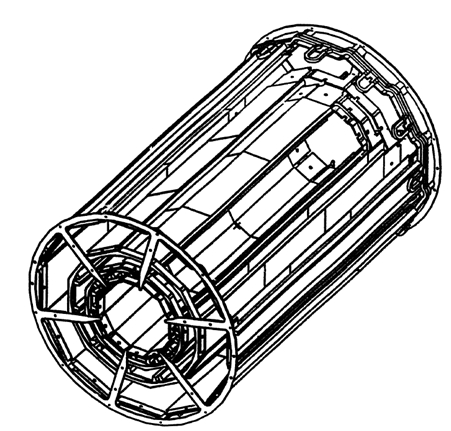Soon after the start of Run 1A a meeting was held at Fermilab to discuss the operational status of the SVX. There were great expectations to see how well the silicon performed. One particular concern was the tracking efficiency: losing even a small fraction of the charged tracks coming from a B hadron vertex could significantly degrade the capability of the detector to identify b-quark-originated jets, which could be the winning weapon to spot top quark decays.
In fact, the detector had been constructed by assembling the silicon sensors in four concentric structures similar to tiles on a roof, such that they would cover as much as possible of the azimuthal angle around the collision point (see figure). Just as roof tiles, each sensor was slightly tilted sideways in order to cover the edge of the one to its right. As suggested by the masterful technician Mike Herzig, the sensors could not touch each other because this would risk damaging the micro-bonds on their edges; some small spatial tolerance had to be left between the adjoining sensors.
The final detector layout had been decided two years earlier by Dante Amidei after a long discussion with Aldo Menzione. Aldo wanted to leave as little space as possible between the tiles, to avoid charged tracks to escape undetected through the non instrumented slits left between them. He actually insisted to design gaps as narrow as one micrometer! Overruling Aldo's requests, Dante chose a way more conservative arrangement.

Figure 1: drawing of the SVX detector, showing one bulkhead and the tiles of silicon crystal ladders assembled in four concentric cylindrical structures.
At the meeting, which was followed in videoconference from Italy, Michigan, and Berkeley, somebody showed the first graph of the measured tracking efficiency of the SVX as a function of azimuth. This was computed by taking well-reconstructed particles measured in the main tracking chamber, the CTC, and studying how many of them failed to match to one of the track segments reconstructed in the SVX.
The graph had overall the nice properties that everybody was expecting: a rather high tracking efficiency for all values of the azimuthal angle, which proved that all the components of the detector were functioning normally. However, some narrow regions were evident showing five percent deficits at regular angular intervals. The low-efficiency regions spatially coincided with the sensor boundaries, where tracks appeared to escape undetected.
The speaker was just starting to comment his results as a loud baritone voice with a strong Italian accent resounded in the room, each word separated from the next in the attempt of making sure they were understood despite the static background of the videoconferencing system from which it was coming, as well as to overcome the language barrier that existed between the owner of the voice and his intended audience.
"Is--Dante--Amidei--listening?"
It was of course Aldo, who was following the meeting from Pisa. Aldo had not forgotten his argument with Amidei about the placement of the silicon sensors, and he wanted to finally make his point with the support of hard data: the tolerance left between the tiles caused a loss of good tracks.
Despite Aldo's scenic debut, it later transpired that the truth was a different one: the inefficiency at the edge of sensors was rather due to the use of a still imperfect algorithm for the reconstruction of the clusters of strips collecting ionization charge. The vertex detector is made of four concentric layers; each layer is made with sensors that have strips parallel to the beams and to the detector axis. When a charged particle emitted from the centre of CDF crosses the SVX, it leaves ionization charge in each layer. The charge is collected in clusters of a few adjoining strips; typically two or three, as the strips are separated by 60 microns. An algorithm called "cluster finder" finds the barycentre of the charge deposition on each layer; that information is then used to reconstruct a track segment by connecting the four spatial points.
Now, when a particle crosses the region where two sensors overlap (the regions object of the diatribe between Aldo and Dante) it may leave some charge on both sensors, which lay at different distances from the beam axis; the special geometry at the edges calls for a special treatment in the determination of the barycentre of charge deposition, which the original cluster finder was not instructed to perform -hence the small inefficiencies observed at the edges in the first SVX data.




Comments